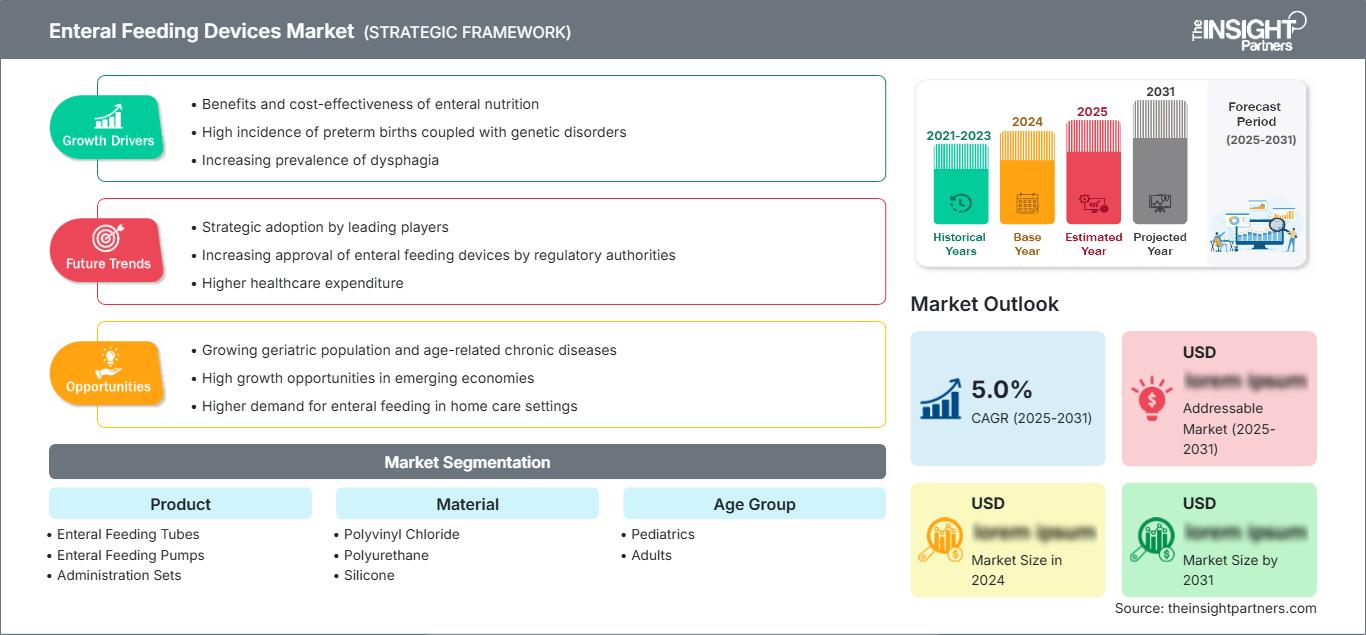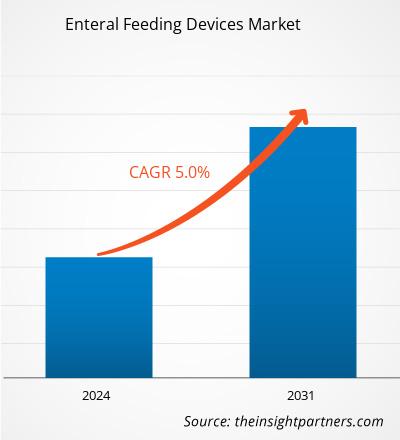Der Markt für enterale Ernährungssysteme wird bis 2031 voraussichtlich ein Volumen von 7,08 Milliarden US-Dollar erreichen. Für den Zeitraum 2025–2031 wird ein jährliches Wachstum von 5,9 % erwartet.
Der Bericht ist nach Art der enteralen Ernährungssysteme segmentiert (Angststörungen, Substanzmissbrauchsstörungen, affektive Störungen, Sonstige). Weiterhin enthält der Bericht Analysen basierend auf dem Material (Polyvinylchlorid (PVC), Polyurethan und Silikon), der Altersgruppe (Kinder und Erwachsene), der Anwendung (Onkologie, gastrointestinale Erkrankungen, neurologische Erkrankungen, Diabetes, Hypermetabolismus und Sonstige Anwendungen) sowie dem Endnutzer (Krankenhäuser, ambulante Operationszentren und häusliche Pflege). Die globale Analyse wird zusätzlich auf regionaler Ebene und für wichtige Länder aufgeschlüsselt. Der Bericht gibt die Werte in US-Dollar für die oben genannten Analysen und Segmente an. Der Marktbericht für enterale Ernährungssysteme von The Insight Partners beschreibt die aktuelle Marktlage und das zukünftige Wachstum, die wichtigsten Treiber, Herausforderungen und Chancen. Er bietet Einblicke für verschiedene Marktteilnehmer, darunter: Technologieanbieter/Hersteller: Um die sich entwickelnde Marktdynamik und potenzielle Wachstumschancen zu verstehen und fundierte strategische Entscheidungen treffen zu können. Investoren: Um eine umfassende Trendanalyse hinsichtlich Marktwachstumsrate, Finanzprognosen und Chancen entlang der Wertschöpfungskette durchzuführen. Regulierungsbehörden: Um Richtlinien zu regulieren und Aktivitäten auf dem Markt zu überwachen, Missbrauch zu minimieren, das Vertrauen der Investoren zu wahren und die Integrität und Stabilität des Marktes zu gewährleisten. Marktsegmentierung für enterale Ernährungssysteme: Produktsegmentierung: Enterale Ernährungssonden, Enterale Ernährungspumpen, Verabreichungssets, Enterale Spritzen. Verbrauchsmaterialien
Material
- Polyvinylchlorid
- Polyurethan
- Silikon
Altersgruppe
- Pädiatrie
- Erwachsene
Anwendung
- Onkologie
- Gastrointestinale Erkrankungen
- Neurologische Erkrankungen
- Diabetes
- Hypermetabolismus
- Sonstige Anwendungen
Endnutzer
- Krankenhäuser
- Ambulante Operationszentren
- Häusliche Pflege
Sie erhalten kostenlos Anpassungen an jedem Bericht, einschließlich Teilen dieses Berichts oder einer Analyse auf Länderebene, eines Excel-Datenpakets sowie tolle Angebote und Rabatte für Start-ups und Universitäten.
Markt für enterale Ernährungsgeräte: Strategische Einblicke

-
Holen Sie sich die wichtigsten Markttrends aus diesem Bericht.Dieses KOSTENLOSE Beispiel umfasst Datenanalysen, die von Markttrends bis hin zu Schätzungen und Prognosen reichen.
Wachstumstreiber des Marktes für enterale Ernährungsgeräte
- Vorteile und Kosteneffizienz der enteralen Ernährung: Sie bezeichnet die direkte Zufuhr von Nährstoffen in den Magen-Darm-Trakt für Patienten, die keine Nährstoffe oral aufnehmen können. Das Wachstum des Marktes für enterale Ernährung ist auf vielfältige Vorteile und Kosteneffizienz zurückzuführen. Enterale Ernährung (EN) führt zu besseren Genesungsraten bei Patienten mit chronischen Erkrankungen oder bei Krankenhausaufenthalten, wenn der Ernährungszustand erhalten oder sogar verbessert wird.
- Hohe Frühgeburtenrate in Verbindung mit genetischen Erkrankungen: Die steigende Zahl von Frühgeburten und genetischen Erkrankungen bei Kindern und Neugeborenen erhöht den Bedarf an enteraler Ernährung. Aufgrund ihres niedrigen Geburtsgewichts haben Frühgeborene aufgrund ihrer weniger entwickelten Organsysteme einen höheren Nährstoffbedarf. Dieser muss daher adäquat durch enterale Ernährung gedeckt werden. Für Kinder mit genetischen Erkrankungen, die die Verdauung und Nährstoffaufnahme beeinträchtigen, kann die enterale Ernährung (EN) eine besser verdauliche Form der Nahrungsaufnahme bieten und die Versorgung mit grundlegenden Nährstoffen sicherstellen.
- Zunehmende Prävalenz von Dysphagie: Dysphagie tritt bei älteren Menschen deutlich häufiger auf, vor allem aufgrund altersbedingter Erkrankungen wie Schlaganfall, neurologischen Erkrankungen und Muskelschwäche. Diese alternde Bevölkerung treibt die Nachfrage nach Lösungen für die enterale Ernährung stetig an. Auch Parkinson, Multiple Sklerose und Amyotrophe Lateralsklerose (ALS) führen häufig zu Dysphagie, die eine Ernährungstherapie mittels EN erforderlich macht. Dies fördert das Marktwachstum.
Zukünftige Trends im Markt für enterale Ernährungssysteme
- Strategische Ausrichtung führender Anbieter: Unternehmen entwickeln kontinuierlich spezifische Produkte für die enterale Ernährung, die auf bestimmte Erkrankungen wie Nieren- und Diabeteserkrankungen sowie auf onkologische Bedürfnisse zugeschnitten sind. Verbesserungen bei Ernährungssonden und Applikationsgeräten erleichtern die Anwendung erheblich und erhöhen den Patientenkomfort deutlich. Zudem bietet dies die Möglichkeit der Anwendung im häuslichen Umfeld.
- Zunehmende Zulassung von enteralen Ernährungssystemen durch die Aufsichtsbehörden: Die Zulassung enteraler Ernährungssysteme durch die Aufsichtsbehörden wird aufgrund des steigenden Bedarfs an sicherer und adäquater Ernährungstherapie, insbesondere in der häuslichen Pflege, zunehmend erfolgen. Die Aufsichtsbehörden genehmigen vermehrt innovative Ernährungstechnologien, die zu besseren Patientenergebnissen beitragen. Für verbesserte Sicherheit, Benutzerfreundlichkeit und Effizienz der Geräte werden die Zulassungen beschleunigt. Die Tendenz der Aufsichtsbehörden zur Zulassung enteraler Ernährungssysteme ist einer der wichtigsten Trends auf dem Markt für enterale Ernährung.
- Höhere Gesundheitsausgaben: Mit dem zunehmenden Einsatz enteraler Ernährung in Gesundheitseinrichtungen als Teil der Routinebehandlung vieler Krankheiten steigen auch die Ausgaben für Produkte und Dienstleistungen im Zusammenhang mit enteraler Ernährung. Die hohen Gesundheitsausgaben stellen einen weiteren wichtigen Trend für den Markt dar, der wiederum eine Folge umfassender wirtschaftlicher Veränderungen und der Ziele im Gesundheitswesen ist.
Marktchancen für enterale Ernährungssysteme
- Wachsende ältere Bevölkerung und altersbedingte chronische Erkrankungen: Ältere Erwachsene leiden unter anderem unter Appetitlosigkeit, Schluckstörungen (Dysphagie) und Malabsorption, was eine angemessene Ernährung erschwert. Die rasch wachsende ältere Bevölkerung und die zunehmende Verbreitung altersbedingter chronischer Erkrankungen eröffnen enorme Chancen im Markt für enterale Ernährung.
- Hohes Wachstumspotenzial in Schwellenländern: Angesichts des Wandels im Gesundheitswesen und der Versorgungsstrukturen in einer alternden Bevölkerung wird Ernährung zunehmend als integraler Bestandteil der ganzheitlichen Versorgung anerkannt, und die Zahl der Anwender enteraler Ernährung steigt. Die rasch wachsende ältere Bevölkerung und die Prävalenz altersbedingter chronischer Erkrankungen bieten starke Chancen für den Markt für enterale Ernährung. Der Markt wird sich weiterentwickeln und Innovationen hervorbringen, die darauf abzielen, die Gesundheit älterer Menschen in Entwicklungsländern zu verbessern, indem sie gezielt auf die Ernährungsbedürfnisse dieser Zielgruppe eingehen.
- Höhere Nachfrage nach enteraler Ernährung in der häuslichen Pflege: Patienten und Angehörige bevorzugen die häusliche Pflege aufgrund des Komforts, der Vertrautheit und der individuellen Umgebung, die enterale Ernährung bietet. Dies ermöglicht die Fortsetzung der Ernährung ohne häufige Krankenhausbesuche. Die zunehmenden Ansprüche auf enterale Ernährung in der häuslichen Pflege bieten dem Markt für enterale Ernährung enorme Chancen.
Markt für Geräte zur enteralen Ernährung
Die regionalen Trends und Faktoren, die den Markt für enterale Ernährungssysteme im Prognosezeitraum beeinflussen, wurden von den Analysten von The Insight Partners ausführlich erläutert. Dieser Abschnitt behandelt außerdem die Marktsegmente und die geografische Verteilung des Marktes für das Management von Herzrhythmusstörungen in Nordamerika, Europa, dem asiatisch-pazifischen Raum, dem Nahen Osten und Afrika sowie Süd- und Mittelamerika.
Umfang des Marktberichts zu Geräten für die enterale Ernährung
| Berichtsattribut | Einzelheiten |
|---|---|
| Marktgröße in 2024 | US$ XX Billion |
| Marktgröße nach 2031 | US$ 7.08 Billion |
| Globale CAGR (2025 - 2031) | 5.9% |
| Historische Daten | 2021-2023 |
| Prognosezeitraum | 2025-2031 |
| Abgedeckte Segmente |
By Produkt
|
| Abgedeckte Regionen und Länder |
Nordamerika
|
| Marktführer und wichtige Unternehmensprofile |
|
Marktdichte bei Geräten zur enteralen Ernährung: Auswirkungen auf die Geschäftsdynamik
Der Markt für enterale Ernährungssysteme wächst rasant, angetrieben durch die steigende Nachfrage der Endverbraucher. Gründe hierfür sind unter anderem sich wandelnde Verbraucherpräferenzen, technologische Fortschritte und ein wachsendes Bewusstsein für die Vorteile des Produkts. Mit steigender Nachfrage erweitern Unternehmen ihr Angebot, entwickeln innovative Lösungen, um den Bedürfnissen der Verbraucher gerecht zu werden, und nutzen neue Trends, was das Marktwachstum zusätzlich beflügelt.

- Holen Sie sich die Markt für enterale Ernährungsgeräte Übersicht der wichtigsten Akteure
Wichtigste Verkaufsargumente
- Umfassende Abdeckung: Der Bericht bietet eine umfassende Analyse der Produkte, Dienstleistungen, Typen und Endnutzer des Marktes für enterale Ernährungssysteme und vermittelt so ein ganzheitliches Bild.
- Expertenanalyse: Der Bericht basiert auf dem fundierten Wissen von Branchenexperten und Analysten.
- Aktuelle Informationen: Der Bericht gewährleistet Geschäftsrelevanz durch die Berücksichtigung aktueller Informationen und Datentrends.
- Anpassungsmöglichkeiten: Dieser Bericht kann an spezifische Kundenanforderungen angepasst werden und sich optimal in die Geschäftsstrategien integrieren.
Der Forschungsbericht zum Markt für enterale Ernährungssysteme kann somit maßgeblich dazu beitragen, das Branchenszenario und die Wachstumsaussichten zu entschlüsseln und zu verstehen. Auch wenn einige berechtigte Bedenken bestehen, überwiegen die Vorteile dieses Berichts insgesamt die Nachteile.
- Historische Analyse (2 Jahre), Basisjahr, Prognose (7 Jahre) mit CAGR
- PEST- und SWOT-Analyse
- Marktgröße Wert/Volumen – Global, Regional, Land
- Branchen- und Wettbewerbslandschaft
- Excel-Datensatz
Aktuelle Berichte
Erfahrungsberichte
Grund zum Kauf
- Fundierte Entscheidungsfindung
- Marktdynamik verstehen
- Wettbewerbsanalyse
- Kundeneinblicke
- Marktprognosen
- Risikominimierung
- Strategische Planung
- Investitionsbegründung
- Identifizierung neuer Märkte
- Verbesserung von Marketingstrategien
- Steigerung der Betriebseffizienz
- Anpassung an regulatorische Trends






















 Kostenlose Probe anfordern für - Markt für enterale Ernährungsgeräte
Kostenlose Probe anfordern für - Markt für enterale Ernährungsgeräte